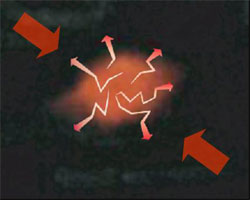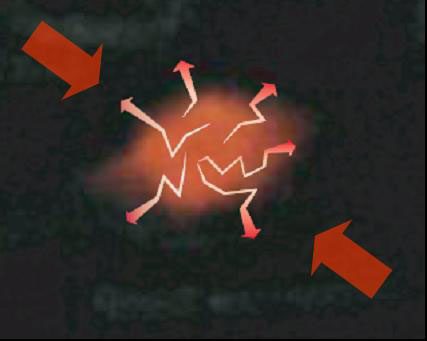The Laser Glow of an Atom Cloud
Random lasers are the “disco ball” version of normal lasers. Instead of beaming in one direction, the light is scattered out in all directions by particles in a powder, for example. Calculations described in the 1 May Physical Review Letters show that a cloud of cold atoms could form a new type of random laser, where individual atoms scatter and amplify the light. The work suggests that the atoms will begin lasing if the cloud can be made opaque, or “cloudy,” enough, which the authors think is within reach of current technology. Because such a system is fundamentally simple, it may give insight into some of the mysteries of random lasers.
A normal laser is essentially a gain medium inside a reflective cavity. The light is amplified by the medium as it bounces back and forth between the cavity’s mirrors. A random laser has no cavity. Instead, tiny “mirrors,” or scatterers, are added to the gain medium, causing photons to bounce around and become amplified by the medium, before escaping in all directions. For example, a container of micron-sized particles floating in water in which a laser dye has also been dissolved can emit laser light if pumped with external light. Random lasers do not require the same precise manufacturing as normal lasers, so they could be inexpensive to produce. Potential applications include digital displays, light emitting paints, and temperature sensors.
There are, however, some uncertainties regarding the spectra and time variability of random lasers [see Focus story: “Photon Marathon”]. So Robin Kaiser of Nice Sophia Antipolis University and the National Center for Scientific Research (CNRS) in France and his colleagues considered a random laser made up of cold atoms. Such a system would not have the absorption and other difficult-to-model complexities of existing random lasers. However, “it was not clear that atoms would be able to play the roles of both gain medium and scatterers,” says Nice team member William Guerin. A single atom scatters photons when it’s in its ground state and amplifies photons (through stimulated emission) when it’s in an excited state, but it can’t do both at the same time. So the researchers needed to find the right balance of atoms in both ground and excited states.
The team modeled a two-level atomic system. In their scenario, a complicated three-photon transition–made possible by an external pump laser–keeps a sufficient fraction of the atoms in the excited state (a so-called population inversion) from which they can provide gain. For different pump frequencies and intensities, the researchers calculated the amount of scattering necessary to trap light in the cloud long enough for it to become true “coherent” laser light, with all the photons propagating in synch. They quantified the amount of scattering within the cloud with a number called the optical thickness [1]. A value between 200 and 250 would lead to lasing, they found, which is within reach of state-of-the-art cold atom traps that currently achieve 150, Guerin says.
The researchers performed a simulation showing that the laser light should be detectable over background light coming from the cloud. They are now trying to make such a random laser in the lab using a standard magneto-optical trap to hold the atoms. Guerin says there are tricks to compress the trap to increase the density and therefore the amount of scattering.
There may, however, be experimental challenges involving the non-uniform density of the cloud, says Diederik Wiersma of the European Laboratory for Non-linear Spectroscopy in Florence, Italy. But if it can work, the use of atoms, rather than micron-scale scatterers, “could enrich our understanding of the random laser phenomena,” Wiersma says. Moreover, because cold atoms are capable of slowing down light, he speculates that they could be more efficient at trapping light than current techniques.
–Michael Schirber
Michael Schirber is a Corresponding Editor for Physics Magazine based in Lyon, France.
References
- The optical thickness–a characterization of the “opaqueness” of the atoms–can be thought of as the diameter of the cloud measured in units of the “mean free path,” which is the typical distance a photon travels before scattering. This refers to scattering with the pump laser turned off, when there is no lasing
More Information
Related info:Focus story: Photon Marathon (2004)
more explanation of random lasers from Wiersma’s lab web site





